History samovar (11 photo + letter)
 Bashny.Net
Bashny.Net
"An hour of friendly conversation at the tea table!
Mistress young and honor and praise! .. »
(PA Vyazemsky)
One of the most striking features of Russian and demonstration of traditional life has long been considered a tea party at the samovar. The samovar was not ordinary household membership, and a kind of personification of wealth, family comfort and prosperity. It included a girl's dowry transferred by inheritance, we gave. Carefully polished, he flaunted in plain view and a place of honor in the room.

Many believe that the samovar - true Russian invention. However, devices like a samovar, were known in ancient times, in ancient times. For example, the Romans, wishing to have a drink of boiling water, took a vessel filled with water and red-hot stone throwing back a little more, causing the water to boil. Over time, and in Europe began to appear similar device, but with a more refined design. And in China even had a device that resembles a samovar that had a chimney and ash pit.
Russian tea machine as it was called in Western Europe first appeared in Russia during the reign of Peter I. At the time, King often visited Holland, where brought many ideas and interesting subjects, among whom was the samovar. It was called, of course, in another way, with the Dutch flavor, but until today the name is not reached and the instrument is known as a samovar.
His appearance is required samovar tea. In Russia tea was introduced in the XVII century in Asia and was used as a medicine among the nobility.
Tea was imported to Moscow, and later in Odessa, Poltava, Kharkiv, Rostov and Astrakhan. The tea trade was one of the vast and profitable businesses. In the XIX century tea became the Russian national drink.
Tea was brought down a competitor, a drink of ancient Russia. This hot drink was prepared with honey and herbs in sbytennyk. Sbytennyk resembles a kettle, which was placed inside the pipe for laying coal. Brisk trade was sbiten fairs.
In the XVIII century in the Urals and in the Tula samovars appeared kitchens, which represented Bratina divided into three parts: two cooked food, in the third - tea.
Sbytennyk samovar-kitchen were the precursors of the samovar.
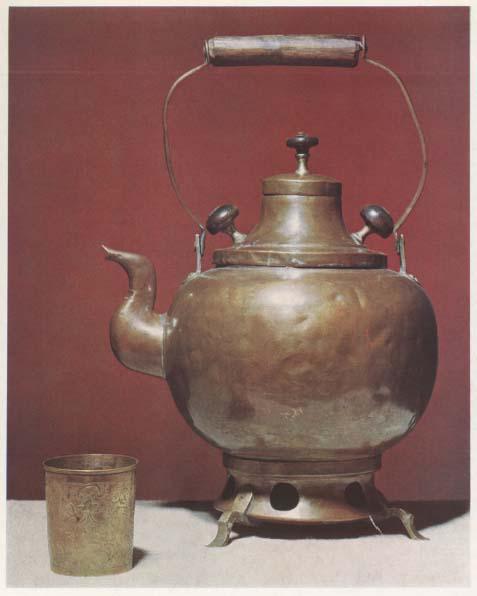
Where and when the first samovar? Who invented it? Unknown. We only know that going to the Urals in 1701, Tula smith-industrialist I. Demidov took with him, and skilled workers, copper craftsmen. It is possible that already in Tula samovars were made.
During the time of Peter the Great in the Urals has begun an unprecedented industry development, to build a huge amount of copper and metallurgical plants. This is one of those plants, and began production of household utensils made of copper for the population, which is already in the 30s of the XVIII century began to produce kettles with handle. A little later, the plants began to make cauldrons and distilleries cubes with the pipes.
The first mention of a samovar in historical documents dates back to the year 1746, but the exact date and place where the first samovar appeared impossible. However, it is known that by the end of the XVIII century and principles of operation of the device itself samovar already formed completely, and remain unchanged.
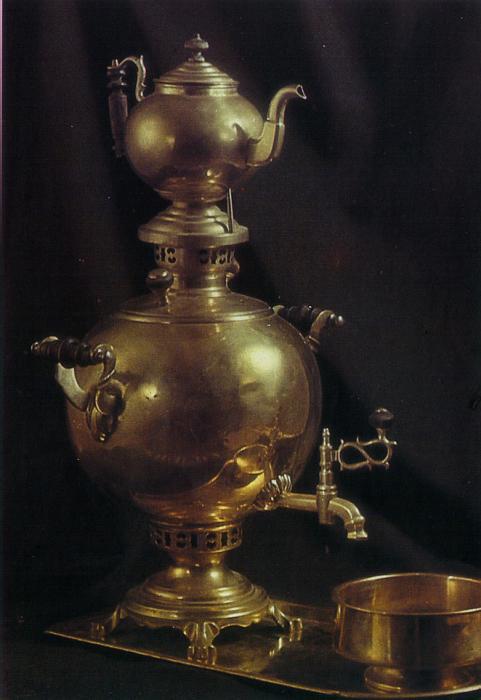
Throughout the history of the samovar its appearance and decoration varied according to the fluctuations of taste. At first they wore the imprint of the Rococo style, then gravitated to the Empire style, and at the end of its existence, did not escape the influence of Art Nouveau. But the "inner content" was traditional. However, in the end of XIX century there was a kerosene samovar and factory Chernikov brothers started producing samovars with a side pipe, which increases air flow and accelerates the boiling process.
The first Russian samovar factory was opened in 1766 in Moscow, Alexander Shmakov. But the real revolution in the art produced Tula samovar. Since the second half of the XIX century Tula becomes "samovar capital". There is at this time there are about 80 factories, produce more than 150 styles of "tea machine".
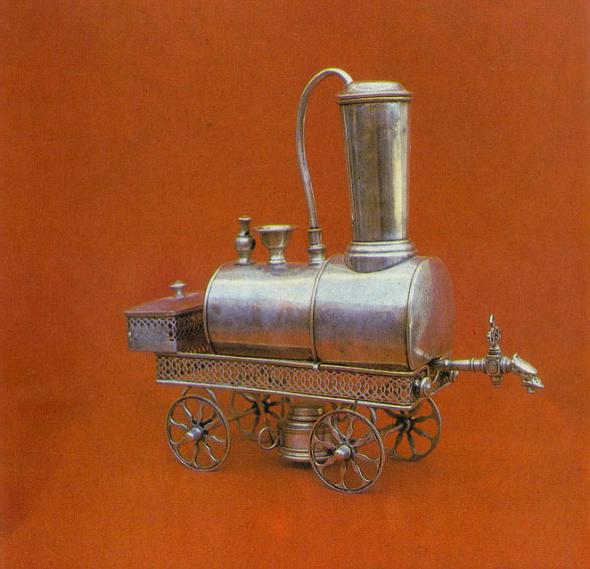
Externally, the first samovar still somewhat different from today. While they are intended primarily for use in field conditions, as a result had a small and removable legs. The most common amount of samovars was 3-8 liters, but produced more volume for a large number of people in the 12-15 liters. Due to the fact that in most of the Russian climate is pretty cool, people drink a day for several cups of tea. In addition, heat the samovar could be quite nice warm room. All this has led to the fact that the samovar became very popular among the people, even though its far lower cost. Among other things, the cost of the samovar was determined based on its weight, that is, the heavier the samovar was, so it was more expensive.
Making samovar - process is quite time consuming. Its manufacturing workers were involved in different specialties: navodyl'schyk that bent copper sheets and asked form tinkers, turners, mechanics, collectors and cleaners. Masters in villages produced parts of the samovar, brought them to the factory, where finished products were collected. Entire villages were engaged in manufacturing parts of the samovar all year except for summer, when the work was carried out in the fields.
First samovars made of red (pure) and green copper, nickel silver, and later began to use cheaper alloys such as brass.
Over time, various factories producing samovars, it became so much that in order to determine the manufacturer, on the covers of samovars became affix the stamp corresponding to each factory. It was something of a trademark for which it was possible to identify the manufacturer.
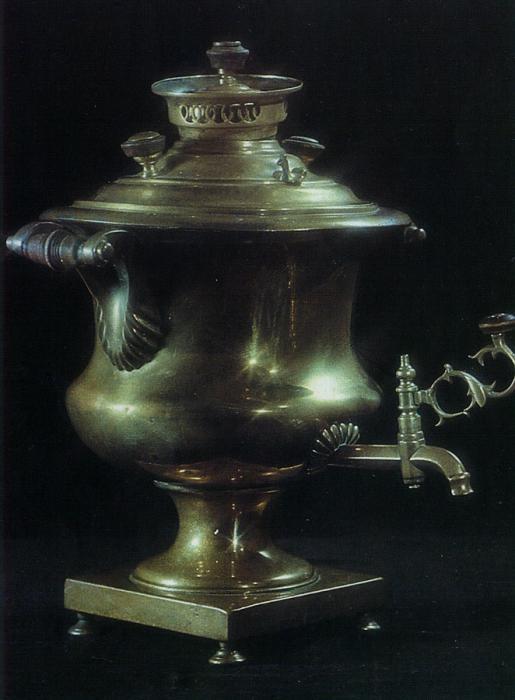
Tula samovars penetrated all corners of Russia, became a decoration fairs. Every year, from May 25 to June 10, from Tula on the river Oka (Oka to samovars carried on horseback) samovars crossed over to the Nizhny Novgorod Fair. River route had a number of advantages: it was cheaper, and samovars with this method of transport is better preserved.
The first took place at fairs Batasheva samovars, Lalin, Belousov, Gudkov, Rudakov, Uvarova, Lomov. Large manufacturers such as Lomovs, Somov, had their shops in Moscow, St. Petersburg, Tula and other cities.
When transporting samovars packed in crates, boxes, which can seat a dozen articles of different sizes and styles, and sold by weight. Dozen samovars weighed over 4 pounds and was worth 90 rubles.

It was not easy to master the craft samovarschika.
That's what says the craftsman-old resident of the village of Maslovo N. Abrosimov: "Work began with a pupil 11 years. Three and a half years he studied the craft. For wall (body) of a certain size cut brass and is then rolled into a cylinder, and this form is induced in twelve steps. Brass on one side notched teeth, and then a hammer secured by a connecting seam, then carried to the forge. Then the master (navodyl'schyk) repeated operations zadelke seam with a hammer and file and each time fixed the annealing in the smithy. We ran into the forge from master to master and from boys and students gradually sizing, as running the wizard.
Many shed sweat and sleepless nights held before the commissioned manufacturer wall made. And you bring to pass in the Tula factory owner, sometimes a marriage finds. Labor took a lot and get nothing. Work hard, but I loved it, it was nice when a sheet of brass do wonder wall ".
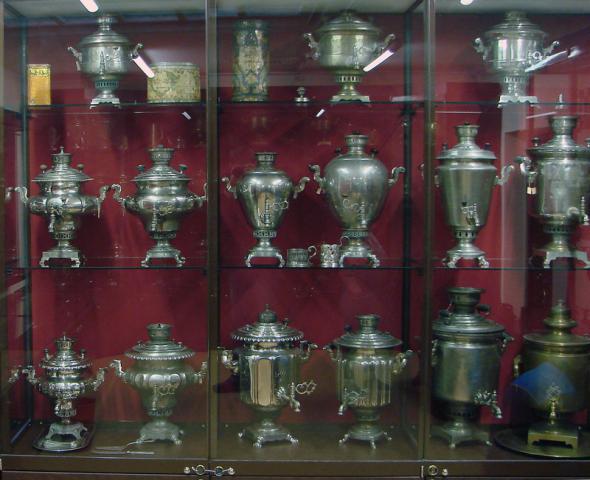
Complex and diverse process of manufacturing "Tula miracle", which amounted to 12 receptions. In the production there was a strict division of labor. There were almost no cases where the master has made to fully entire samovar. The samovar was actually seven major specialties:
Navodyl'schyk - bent copper sheet, solder it and excrete the appropriate form. For a week he could The beaten 6-8 pieces pieces (depending on the form) and received an average of 60 cents per share.
Tinker - vyluzhival inside of the tin samovar. Did 60-100 pieces a day and received by 3 pennies apiece.
Turner - sharpening on the machine and polished samovar (the worker who turned the machine (vertelschik) received 3 rubles per week). Turner could carve 8-12 pieces per day, and received 18-25 cents per share.
Locksmith - made handles, taps and so on. N. (Pen - samovars to 3-6 per day), and for each pair received 20 cents.
The garbage - from all parts collected samovar soldered taps and so. N. A week to do two dozen samovars and received with a 23-25 kopecks.
Cleaner - cleans samovar (up to 10 units per day), I received 7-10 cents apiece.
Turners - He produced wooden cones to cover and handle (on the day - up to 400-600 pieces) and received 10 cents per hundred.
Lengthy process of manufacturing the samovar before it appears in the form in which we are accustomed to seeing.
In the factories there was the assembly and finishing. Manufacturing of parts - in their homes. It is known that whole villages produced one some detail. Letting finished products was accomplished once per week, two times a week. Carried finished products to pass on horseback, well packaged.
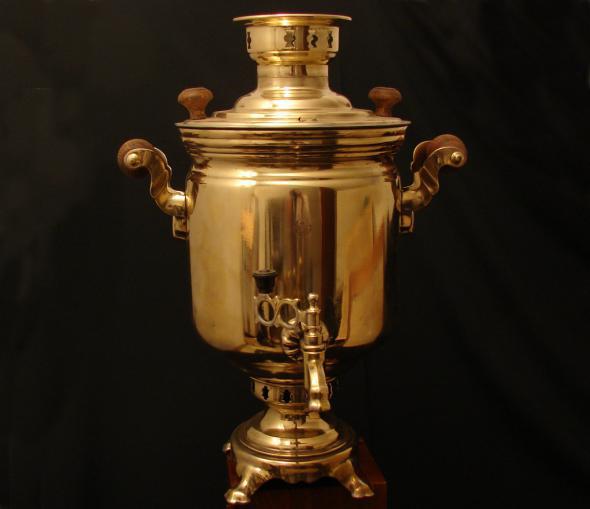
Samovar entered every house became a feature of Russian life. Poet Boris Sadouskaya in the preface to the book "Samovar" wrote: "The samovar in our lives unconsciously to ourselves, great ranks. As a purely Russian phenomenon, it is the understanding of foreigners. Russian man in the buzz and whispers samovar chudyatsya childhood familiar voice sighs spring wind, the familiar songs of the mother, a cheerful whistle beckoning village blizzard. Of the votes in a city European cafe inaudible ».
On the eve of the War of 1812 the largest enterprise for the production of samovars was a factory of Peter Silin, who was in Moscow province. It is produced in a year there are about 3000 pieces, but by the 1820s an increasingly important role in the production of the samovar began to play Tula.
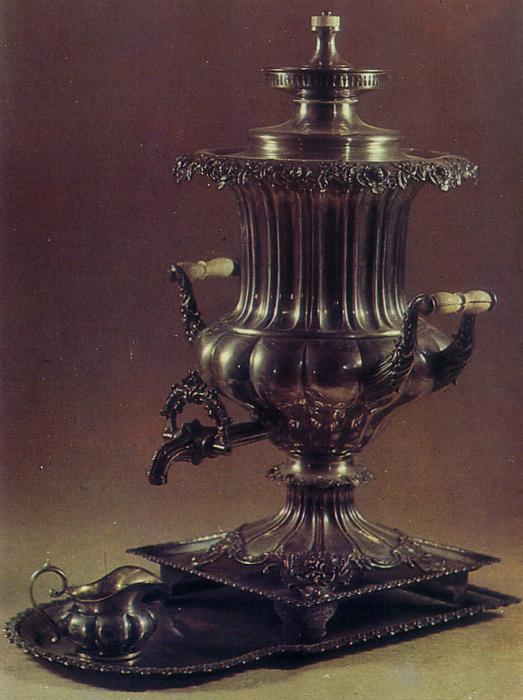
Samovar - a part of life and the fate of our people, as reflected in its proverbs and sayings, in the works of the classics of our literature - Pushkin, Gogol, Gorky and Blok.
Samovar - it's poetry. This kind Russian hospitality. It is a circle of friends and family, the warm and cordial rest.
Hops twined veranda window, summer night, with its sounds and smells of the delights which the heart stops, the circle of light from the lamp with a fabric shade and a cozy, of course ... nagging, gleaming copper, bursting steam Tula samovar on the table.
Tula samovar ... In our language, this phrase has long been stable. Ironic, from his point of view, the act of Chekhov compares with a trip "in the Tula samovar with its own».
Already at that time of the samovar evolved proverbs ("The samovar is boiling - leave will not allow", "Where there is tea, there under spruce paradise"), songs, poems.
Newspaper "Tula province news" for 1872 (№ 70) on the samovar wrote: "Samovar - A friend of the family hearth, medicine prozyabshego traveler ...»

The history of Russian samovar is not too long - about two and a half centuries. But today, the samovar - an integral part of Russian tea. Samples of Russian samovars can be found on the antiques market. The price of such samovars depends, of course, from reputable companies or the master, of the preservation of the sample material from the product. Prices start from samovars collection of 500 dollars. The most expensive samovars - samovars firm Faberge, whose prices can reach up to 25 000 dollars.
Samovar can create amazingly warm and cozy atmosphere in the house, add a unique flavor to family and friendly gatherings, recall long-forgotten, but such pleasant Russian traditions.
It was getting dark. On the table, shining,
Evening samovar hissed,
Chinese teapot heating,
Under it curled easy pairs.
Spilled Olga's hand.
Cups a dark jet
The fragrant tea was ...
via p-i-f

Source:
Mistress young and honor and praise! .. »
(PA Vyazemsky)
One of the most striking features of Russian and demonstration of traditional life has long been considered a tea party at the samovar. The samovar was not ordinary household membership, and a kind of personification of wealth, family comfort and prosperity. It included a girl's dowry transferred by inheritance, we gave. Carefully polished, he flaunted in plain view and a place of honor in the room.

Many believe that the samovar - true Russian invention. However, devices like a samovar, were known in ancient times, in ancient times. For example, the Romans, wishing to have a drink of boiling water, took a vessel filled with water and red-hot stone throwing back a little more, causing the water to boil. Over time, and in Europe began to appear similar device, but with a more refined design. And in China even had a device that resembles a samovar that had a chimney and ash pit.
Russian tea machine as it was called in Western Europe first appeared in Russia during the reign of Peter I. At the time, King often visited Holland, where brought many ideas and interesting subjects, among whom was the samovar. It was called, of course, in another way, with the Dutch flavor, but until today the name is not reached and the instrument is known as a samovar.
His appearance is required samovar tea. In Russia tea was introduced in the XVII century in Asia and was used as a medicine among the nobility.
Tea was imported to Moscow, and later in Odessa, Poltava, Kharkiv, Rostov and Astrakhan. The tea trade was one of the vast and profitable businesses. In the XIX century tea became the Russian national drink.
Tea was brought down a competitor, a drink of ancient Russia. This hot drink was prepared with honey and herbs in sbytennyk. Sbytennyk resembles a kettle, which was placed inside the pipe for laying coal. Brisk trade was sbiten fairs.
In the XVIII century in the Urals and in the Tula samovars appeared kitchens, which represented Bratina divided into three parts: two cooked food, in the third - tea.
Sbytennyk samovar-kitchen were the precursors of the samovar.

Where and when the first samovar? Who invented it? Unknown. We only know that going to the Urals in 1701, Tula smith-industrialist I. Demidov took with him, and skilled workers, copper craftsmen. It is possible that already in Tula samovars were made.
During the time of Peter the Great in the Urals has begun an unprecedented industry development, to build a huge amount of copper and metallurgical plants. This is one of those plants, and began production of household utensils made of copper for the population, which is already in the 30s of the XVIII century began to produce kettles with handle. A little later, the plants began to make cauldrons and distilleries cubes with the pipes.
The first mention of a samovar in historical documents dates back to the year 1746, but the exact date and place where the first samovar appeared impossible. However, it is known that by the end of the XVIII century and principles of operation of the device itself samovar already formed completely, and remain unchanged.

Throughout the history of the samovar its appearance and decoration varied according to the fluctuations of taste. At first they wore the imprint of the Rococo style, then gravitated to the Empire style, and at the end of its existence, did not escape the influence of Art Nouveau. But the "inner content" was traditional. However, in the end of XIX century there was a kerosene samovar and factory Chernikov brothers started producing samovars with a side pipe, which increases air flow and accelerates the boiling process.
The first Russian samovar factory was opened in 1766 in Moscow, Alexander Shmakov. But the real revolution in the art produced Tula samovar. Since the second half of the XIX century Tula becomes "samovar capital". There is at this time there are about 80 factories, produce more than 150 styles of "tea machine".

Externally, the first samovar still somewhat different from today. While they are intended primarily for use in field conditions, as a result had a small and removable legs. The most common amount of samovars was 3-8 liters, but produced more volume for a large number of people in the 12-15 liters. Due to the fact that in most of the Russian climate is pretty cool, people drink a day for several cups of tea. In addition, heat the samovar could be quite nice warm room. All this has led to the fact that the samovar became very popular among the people, even though its far lower cost. Among other things, the cost of the samovar was determined based on its weight, that is, the heavier the samovar was, so it was more expensive.
Making samovar - process is quite time consuming. Its manufacturing workers were involved in different specialties: navodyl'schyk that bent copper sheets and asked form tinkers, turners, mechanics, collectors and cleaners. Masters in villages produced parts of the samovar, brought them to the factory, where finished products were collected. Entire villages were engaged in manufacturing parts of the samovar all year except for summer, when the work was carried out in the fields.
First samovars made of red (pure) and green copper, nickel silver, and later began to use cheaper alloys such as brass.
Over time, various factories producing samovars, it became so much that in order to determine the manufacturer, on the covers of samovars became affix the stamp corresponding to each factory. It was something of a trademark for which it was possible to identify the manufacturer.

Tula samovars penetrated all corners of Russia, became a decoration fairs. Every year, from May 25 to June 10, from Tula on the river Oka (Oka to samovars carried on horseback) samovars crossed over to the Nizhny Novgorod Fair. River route had a number of advantages: it was cheaper, and samovars with this method of transport is better preserved.
The first took place at fairs Batasheva samovars, Lalin, Belousov, Gudkov, Rudakov, Uvarova, Lomov. Large manufacturers such as Lomovs, Somov, had their shops in Moscow, St. Petersburg, Tula and other cities.
When transporting samovars packed in crates, boxes, which can seat a dozen articles of different sizes and styles, and sold by weight. Dozen samovars weighed over 4 pounds and was worth 90 rubles.

It was not easy to master the craft samovarschika.
That's what says the craftsman-old resident of the village of Maslovo N. Abrosimov: "Work began with a pupil 11 years. Three and a half years he studied the craft. For wall (body) of a certain size cut brass and is then rolled into a cylinder, and this form is induced in twelve steps. Brass on one side notched teeth, and then a hammer secured by a connecting seam, then carried to the forge. Then the master (navodyl'schyk) repeated operations zadelke seam with a hammer and file and each time fixed the annealing in the smithy. We ran into the forge from master to master and from boys and students gradually sizing, as running the wizard.
Many shed sweat and sleepless nights held before the commissioned manufacturer wall made. And you bring to pass in the Tula factory owner, sometimes a marriage finds. Labor took a lot and get nothing. Work hard, but I loved it, it was nice when a sheet of brass do wonder wall ".

Complex and diverse process of manufacturing "Tula miracle", which amounted to 12 receptions. In the production there was a strict division of labor. There were almost no cases where the master has made to fully entire samovar. The samovar was actually seven major specialties:
Navodyl'schyk - bent copper sheet, solder it and excrete the appropriate form. For a week he could The beaten 6-8 pieces pieces (depending on the form) and received an average of 60 cents per share.
Tinker - vyluzhival inside of the tin samovar. Did 60-100 pieces a day and received by 3 pennies apiece.
Turner - sharpening on the machine and polished samovar (the worker who turned the machine (vertelschik) received 3 rubles per week). Turner could carve 8-12 pieces per day, and received 18-25 cents per share.
Locksmith - made handles, taps and so on. N. (Pen - samovars to 3-6 per day), and for each pair received 20 cents.
The garbage - from all parts collected samovar soldered taps and so. N. A week to do two dozen samovars and received with a 23-25 kopecks.
Cleaner - cleans samovar (up to 10 units per day), I received 7-10 cents apiece.
Turners - He produced wooden cones to cover and handle (on the day - up to 400-600 pieces) and received 10 cents per hundred.
Lengthy process of manufacturing the samovar before it appears in the form in which we are accustomed to seeing.
In the factories there was the assembly and finishing. Manufacturing of parts - in their homes. It is known that whole villages produced one some detail. Letting finished products was accomplished once per week, two times a week. Carried finished products to pass on horseback, well packaged.

Samovar entered every house became a feature of Russian life. Poet Boris Sadouskaya in the preface to the book "Samovar" wrote: "The samovar in our lives unconsciously to ourselves, great ranks. As a purely Russian phenomenon, it is the understanding of foreigners. Russian man in the buzz and whispers samovar chudyatsya childhood familiar voice sighs spring wind, the familiar songs of the mother, a cheerful whistle beckoning village blizzard. Of the votes in a city European cafe inaudible ».
On the eve of the War of 1812 the largest enterprise for the production of samovars was a factory of Peter Silin, who was in Moscow province. It is produced in a year there are about 3000 pieces, but by the 1820s an increasingly important role in the production of the samovar began to play Tula.

Samovar - a part of life and the fate of our people, as reflected in its proverbs and sayings, in the works of the classics of our literature - Pushkin, Gogol, Gorky and Blok.
Samovar - it's poetry. This kind Russian hospitality. It is a circle of friends and family, the warm and cordial rest.
Hops twined veranda window, summer night, with its sounds and smells of the delights which the heart stops, the circle of light from the lamp with a fabric shade and a cozy, of course ... nagging, gleaming copper, bursting steam Tula samovar on the table.
Tula samovar ... In our language, this phrase has long been stable. Ironic, from his point of view, the act of Chekhov compares with a trip "in the Tula samovar with its own».
Already at that time of the samovar evolved proverbs ("The samovar is boiling - leave will not allow", "Where there is tea, there under spruce paradise"), songs, poems.
Newspaper "Tula province news" for 1872 (№ 70) on the samovar wrote: "Samovar - A friend of the family hearth, medicine prozyabshego traveler ...»

The history of Russian samovar is not too long - about two and a half centuries. But today, the samovar - an integral part of Russian tea. Samples of Russian samovars can be found on the antiques market. The price of such samovars depends, of course, from reputable companies or the master, of the preservation of the sample material from the product. Prices start from samovars collection of 500 dollars. The most expensive samovars - samovars firm Faberge, whose prices can reach up to 25 000 dollars.
Samovar can create amazingly warm and cozy atmosphere in the house, add a unique flavor to family and friendly gatherings, recall long-forgotten, but such pleasant Russian traditions.
It was getting dark. On the table, shining,
Evening samovar hissed,
Chinese teapot heating,
Under it curled easy pairs.
Spilled Olga's hand.
Cups a dark jet
The fragrant tea was ...
via p-i-f

Source:
Tags
See also
Cars on the streets of London
My friend - Kettle. Discussions with appliances save from depression! :)))
Dmitry Shamenkov: How to find your purpose
The history of "Artek"
Stories about witches
From the history of the police (55 photos)
The world's first computer
See and die. (24 ph + letter)
"Finest hour"
Facts about the comedy "Beware of the Car"

















